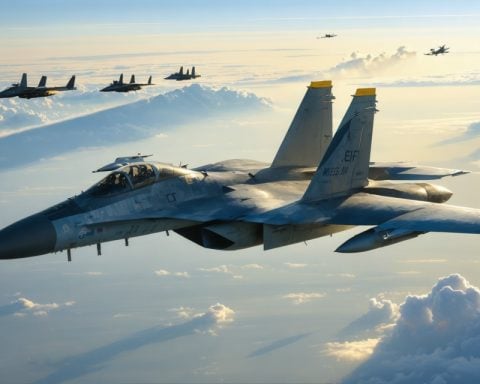- Chinese military maneuvers in the Taiwan Strait are escalating, with increased air and naval presence seen as provocative by Taiwan.
- 28 Chinese aircraft crossed the median line, challenging Taiwan’s defenses and raising tensions.
- A Canadian frigate patrol highlights international support for a free and open Indo-Pacific.
- China criticizes foreign presence in the strait, seeing it as a threat to peace and stability.
- The Eastern Theatre Command of China shows readiness to respond militarily as tensions rise.
- The United States, Japan, and South Korea express solidarity with Taiwan, opposing changes to the status quo through force.
- China’s growing military capabilities, including amphibious and naval advancements, add to the volatile dynamics in the region.
- The Taiwan Strait remains a focal point of geopolitical significance, affecting global peace and security.
A storm brews over the Taiwan Strait as the latest surge in Chinese military maneuvers intensifies global attention on this volatile region. Before the morning sun touched the landscape, Taiwan’s Ministry of National Defense unveiled a disconcerting scene: 41 Chinese aircraft, nine naval vessels, and an official ship prowling the waters. The air seemed electric as 28 aircraft dared cross the median line, challenging Taiwan’s defenses and unsettling the tranquil passage once assumed neutral.
The theater of contention widened as a Canadian frigate charted a course through these tense waters, underscoring international resolve to uphold a “free and open Indo-Pacific.” Canada, casting its own maritime message, reflected a growing chorus of support echoing from continents afar.
In Beijing, a quieter storm of reproach gathered as China voiced vehement disapproval. The presence in the strait, they argued, frayed the threads of peace. Shadowing these moves, the Eastern Theatre Command of the People’s Liberation Army affirmed its readiness, deploying forces to signal that every stir in the watery expanse drew watchful eyes.
As diplomatic resonance followed military movement, the Taiwan Strait evolved into a tapestry of geopolitical significance. The United States, Japan, and South Korea stood united, reaffirming their unwavering commitment to Taiwan’s security and its suitably precarious international role. They conveyed, in measured tones, that force or coercion should not rewrite the status quo.
Against this backdrop, China carves and sharpens its military potential, lading it with amphibious prowess and sophisticated naval machinery. The world watches as the waters ripple with possibility, a potent reminder of Taiwan’s pivotal place in international discourse.
Through the mist of maritime maneuvering and diplomatic declarations, the message resonates: the Taiwan Strait’s security concerns us all. In the dance of nations, peace here reverberates far beyond the shorelines.
A Growing Tension: The Taiwan Strait’s Global Implications and Strategic Responses
How-To Steps & Life Hacks in Navigating Geopolitical Tensions
– Stay Informed: To keep abreast of developments regarding geopolitical tensions like those in the Taiwan Strait, set up news alerts from reputable international sources such as Reuters, BBC, and The New York Times.
– Analyze Multiple Perspectives: Examine the situation from different geopolitical lenses—Chinese, Taiwanese, Western—to understand the motivations and implications of actions in the region.
– Engage in Dialogue: Discusses these topics in forums or with knowledgeable people to gain deeper insights and foster understanding.
Real-World Use Cases: The Importance of International Naval Presence
International naval forces play a significant role in maintaining the balance of power in strategically critical waterways. The presence of Canadian, American, and other allied ships in the Taiwan Strait serves as a deterrent against potential unilateral military actions by China and reassures allied nations regarding the commitment to a “free and open Indo-Pacific.”
Market Forecasts & Industry Trends
1. Defense Spending Uptrend: With rising tensions, global defense spending, particularly in the Asia-Pacific region, is likely to increase. Nations may bolster their naval capabilities to secure maritime routes and assert territorial claims.
2. Technological Advances: Investments in technology like AI, drones, and cyber warfare as countries seek to gain strategic advantages without direct conflict.
Reviews & Comparisons: Military Capabilities
Comparing the military capabilities of the countries involved can provide insight into the dynamics of the Taiwan Strait:
– China: Massive investments in military modernization, capable of amphibious operations, advanced missile systems.
– Taiwan: Smaller scale but focuses on asymmetric warfare strategies with significant backing and support from the U.S.
– Allied Forces: Collective military strength and superior technology, including air and naval superiority.
Controversies & Limitations
– Escalation Risks: Increased military maneuvers can inadvertently escalate tensions, leading to conflict.
– Economic Impact: Tensions can disrupt global supply chains and trade, with Taiwan being a crucial hub for semiconductor manufacturing.
Features, Specs & Pricing of Naval Assets
Countries involved have a range of naval assets:
– Aircraft Carriers: The U.S. operates several in the Pacific, crucial for power projection.
– Destroyers and Frigates: Advanced missile systems and stealth capabilities for all involved parties, with variations in deck size, weaponry, and defense systems.
Security & Sustainability
– Cybersecurity: Enhanced cyber defenses are critical; Taiwan has been at the forefront, given China’s advanced cyber capabilities.
– Environmental Considerations: Naval exercises have drawn criticism for potential environmental harm, emphasizing the need for sustainable practices.
Insights & Predictions
– Short-to-Medium Term: Expect continued military posturing, with diplomatic channels attempting to mitigate tensions.
– Long-Term: Could lead to more robust international peacekeeping agreements or a new status quo that shifts the current balance.
Tutorials & Compatibility
– Understanding Alliances: Learn about the intricate network of alliances in the Indo-Pacific through historical contexts and current pacts like the Quad (U.S., Japan, India, Australia).
Pros & Cons Overview
Pros:
– Reinforcement of international law and sovereignty.
– Deterrent against potential aggressions.
Cons:
– Risk of accidental military conflict.
– Strain on bilateral relations, especially for regional players.
Actionable Recommendations
– Regularly review regional military actions and diplomatic talks.
– Businesses should assess geopolitical risks as factors in their global economic strategies.
– Citizens should engage policymakers to prioritize diplomatic resolutions over military posturing.
For more information on global security issues and alliances, visit NATO. This will provide further context to the diplomatic, military, and economic complexities surrounding the Taiwan Strait situation.







